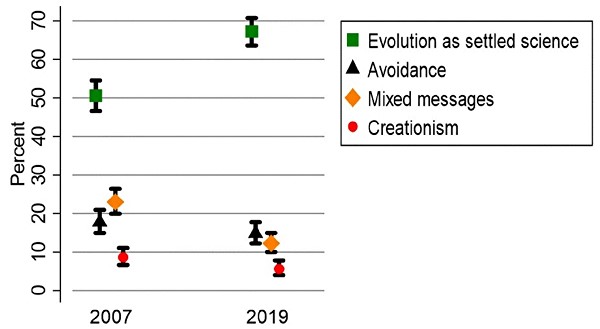Reason for optimism in the evolution wars

The title of this article, Teaching evolution in U.S. public schools: a continuing challenge, seems to me a little sterile and possibly unduly pessimistic. The main conclusions of the article are given in the figure: The fraction of teachers who teach evolution has increased from 50 to nearly 70 % in the 12 years since an earlier survey. Additionally, the fraction who teach creationism has fallen, and the fraction who give “mixed messages” has fallen precipitously, from the low 20’s to the low teens.
Among other conclusions, the authors credit the Next Generation Science Standards for the improvement.
The article is too detailed to regurgitate here, but it is easy to read (and free!). The authors, for example, compare responses from teachers in states that have adopted the NGSS or a similar Framework with teachers in the remaining states before crediting NGSS with the improvements. They looked at other data to conclude that the improvements were not the result of new teachers being hired after Kitzmiller and NGSS. Rather, older teachers, on the job before Kitzmiller, took advantage of professional-development courses and improved their teaching of evolution and increased the time they devoted to it.
Additionally, the fraction of teachers who “strongly disagreed” with the statement, “I emphasize that intelligent design is a valid, scientific alternative to Darwinian explanations for the origin of species,” increased from 20 to 43 % in the 12 years between the polls. Likewise, the fraction who strongly disagreed with the statement, “I emphasize that many reputable scientists view creationism or intelligent design as valid alternatives to Darwinian theory,” increased from 13 to 20 %. Only 3 % “strongly agreed” with the either statement, a number that remained constant across the 12 years.
All in all, I thought it was a pretty good decade or so.
